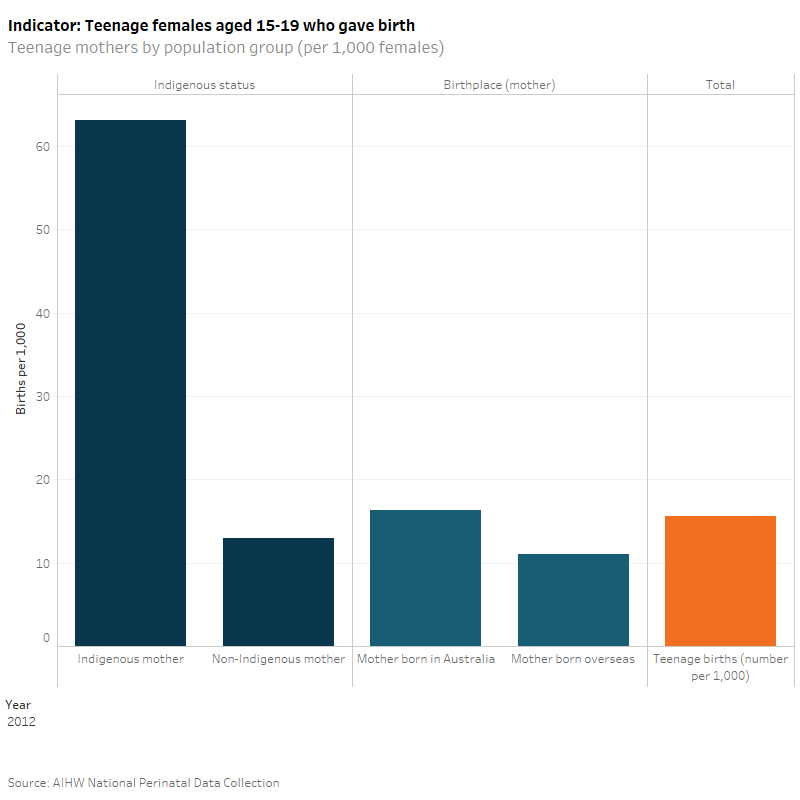Teenage mothers
Why are rates about teenage mothers important?
Teenage parenthood can be a positive and maturing experience for young people. However, teenage motherhood is also associated with poorer health and wellbeing outcomes for both mother and baby throughout life. Babies born to teenage mothers have an increased risk of pre-term birth, low birthweight and associated complications (Gupta et al. 2008). Children born to teenage mothers may also be more likely to have poorer emotional, cognitive and behavioural outcomes and to be born into and continue to live in disadvantaged socioeconomic situations (Paranjothy et al. 2009; Chittleborough et al. 2011).
A number of factors have been associated with teenage birth, with the most widely cited being a family history of teenage pregnancy, socioeconomic disadvantage, one-parent family structure and family breakdown (Gaudie et al. 2010).
Factors that affect the future for young mothers include their level of disadvantage before they became pregnant, and difficulties associated with completing school or undertaking further study or employment after childbirth. Younger mothers and their children may also be at higher risk of social exclusion, which can affect access to important health, housing, education and employment services (Butler et al. 2010).
While not all teenage births result in negative outcomes for mother and child, the factors that often contribute to teenage birth mean that many young mothers do not receive the support they need during pregnancy and after the birth.
Do rates vary across population groups?
According to the AIHW National Perinatal Data Collection, in 2012, 11,058 young women under the age of 20 gave birth, a rate of about 16 per 1,000 young women. The crude age specific rate among Indigenous young women was over 4 times as high as non-Indigenous young women (63 compared to 13 per 1,000 young women). The rate for overseas-born young mothers was lower (11 per 1,000 young women) than the rate for Australian-born mothers (16 per 1,000 young women).
In 2012, 84% of young mothers aged under 20 had given birth for the first time, with the remaining 16% having given birth at least once before.
Has there been a change over time?
The rate of teenage women giving birth has gradually declined between 2003 and 2012 from 17.4 to 15.6 per 1,000 young women. The Indigenous rate has shown a greater decline during this period from 77 to 63 per 1,000. In the 4 years to 2012, the rate for overseas-born young women has remained relatively stable (10.6 per 1,000 in 2009 compared with 11 per 1,000 in 2012).
The proportion of young women aged under 20 who were first-time mothers has remained relatively stable between 2003 (83%) and 2012 (84%).

There are a few births to mothers under the age of 15 years in Australia. These are included in this indicator.
Parity is the number of a woman’s previous pregnancies that resulted in a birth of at least 20 weeks gestation or weighing at least 400 grams at birth.
Data by Indigenous status for 2003 and 2004 exclude Tasmania because the ‘Not stated’ category for Indigenous status was not able to be distinguished from the ‘Neither Aboriginal nor Torres Strait Islander origin’ category.
Data by birthplace of mother for 2003–2008 are excluded due to the use of different classifications of countries, affecting comparability.
Data on parity for 2009 and 2010 exclude Victoria as parity was not reported for these years.
Provisional data was supplied by Victoria in 2009, 2010 and 2012.
For more information on teenage mothers, see Australia’s mothers and babies 2012 and the Perinatal data portal.
AIHW National Perinatal Data Collection
Data quality statement: AIHW METeOR
Butler K, Winkworth G, McArthur M, Smyth, J 2010. Experiences and aspirations of younger mothers. Report for the Department of Families, Housing, Community Services and Indigenous Affairs Institute of Child Protection Studies Australian Catholic University. Canberra: Insitute of Child Protection Studies, Australian Catholic University.
Chittleborough CR, Lawlor DA & Lynch JW 2011. Young maternal age and poor child development: predictive validity from a birth cohort. Pediatrics 127(6):e1436–e44.
Gaudie J, Mitrou F, Lawrence D, Stanley F, Silburn S & Zubrick S 2010. Antecedents of teenage pregnancy from a 14-year follow-up study using data linkage. BMC Public Health 10(1):63.
Gupta N, Kiran U & Bhal K 2008. Teenage pregnancies: obstetric characteristics and outcome. European Journal of Obstetrics & Gynecology and Reproductive Biology 137(2):165–71.
Paranjothy S, Broughton H, Adappa R, Fone D 2009. Teenage pregnancy: who suffers? Archives of Diseases in Childhood 94:239–245.


